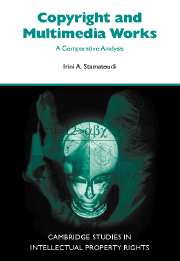Book contents
- Frontmatter
- Contents
- Acknowledgments
- List of abbreviations
- Introduction
- 1 Placing multimedia products within the scope of copyright
- 2 The scope of multimedia works
- 3 Traditional literary works
- 4 Collections and compilations
- 5 Databases
- 6 Audiovisual works
- 7 Computer programs
- 8 Video games as a test case
- 9 Multimedia products and existing categories of copyright works
- 10 A regime of protection for multimedia products
- 11 Conclusions
- Postscript
- Bibliography
- Index
8 - Video games as a test case
Published online by Cambridge University Press: 25 July 2009
- Frontmatter
- Contents
- Acknowledgments
- List of abbreviations
- Introduction
- 1 Placing multimedia products within the scope of copyright
- 2 The scope of multimedia works
- 3 Traditional literary works
- 4 Collections and compilations
- 5 Databases
- 6 Audiovisual works
- 7 Computer programs
- 8 Video games as a test case
- 9 Multimedia products and existing categories of copyright works
- 10 A regime of protection for multimedia products
- 11 Conclusions
- Postscript
- Bibliography
- Index
Summary
VIDEO GAMES AS MULTIMEDIA WORKS
The only ‘multimedia cases’ that have come before the various national courts up to now are cases on video games. Indeed, video games were the first forms of multimedia products that appeared on the market. ‘Multimedia works’ is a generic term and as such it is capable of encompassing a great variety of products. Some of them are already on the market whilst others have yet to appear. These products can be considered to come under the umbrella of multimedia works provided that they contain the essential elements or the common core of a multimedia work.
Video games possess the general/basic characteristics of a multimedia work. They combine on one medium (either off-line or on-line) different forms of expression in a digitised format. Images and sound are the most frequently combined expressions, though text can also be included, usually in the form of commands, pathways or score results. All these elements make up the visual effect (sights and sounds) of the video game. The visual element is an audiovisual expression as long as images and sound, or images alone, or images as the main element are projected onto a screen. If that is not the case then, although the visual element necessarily remains, since the video game can only be displayed on screen, the audiovisual expression is replaced by a literary (if it is primarily text that is included) or other expression and it is on these grounds that the product qualifies as a work.
- Type
- Chapter
- Information
- Copyright and Multimedia ProductsA Comparative Analysis, pp. 166 - 185Publisher: Cambridge University PressPrint publication year: 2001



